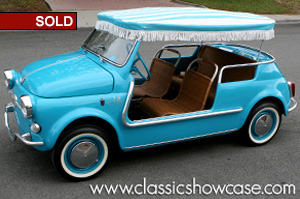1957 Fiat 500 Jolly
Specifications |
|
| Stock: | FI57-003 |
| Current condition: | SHOW |
| Performance: | 500-cc, 13-hp two-cylinder engine |
| Transmission: | 4 speed manual |
| Suspension: | Coil-spring Independent Front Suspension, Trailing Arm Coil-Spring Rear Suspension |
| Color exterior: | Turquoise Blue and White |
| Color interior: | Wicker, with Surrey Top |
| Mileage: | 37,644 believed original, with less than 500 miles since restoration |
| Tires: | BF Goodrich Silver Stone 40/50/12 Whitewalls |
| Brakes: | Four-wheel Hydraulic Drum Brakes |
| Vin #: | 110076003 |
| Engine #: | 110000*992116 |

Description
(SOLD) This Turquoise Blue and White Jolly has been previously restored by the professionals at Classic Showcase, and is presented extremely well today. The car has been recently serviced, and is very well detailed throughout - from the engine bay to the trunk placed at the front of the car, the Jolly is full of charm and character where it counts. Moving this “beach cruiser” down the road is the 479-cid air-cooled, two-cylinder engine. Backing the engine is a floor-shift, four-speed manual transmission. The Fiat is complete with wicker seating, matching Turquoise Blue & White Surrey top, seat belts, spare tire, body-color steel wheels, polished wheel covers and thin whitewall tires. This Fiat Jolly is a unique choice to add to one's collection, or may be driven and enjoyed at your favorite resort or coastal area.
History
When the Fiat 500 was introduced in 1957, it was marketed as a city car. Dimensions for the car came to just under 10-feet. It was powered by an appropriate 479-cc two-cylinder, rear-mounted engine. This tiny car set the standard for what a “city car” should be. Some enthusiasts believe that the Jolly was made to compete with the popular Volkswagen Beetle. A custom Jolly version of the 500 was created by Ghia in limited numbers. It is commonly seen without doors with a canopy-style roof and wicker seats throughout the interior. It is believed that up to 400 Fiats were “customized” into Jolly’s; and it is believed that less than 100 original Ghia built examples remain.
